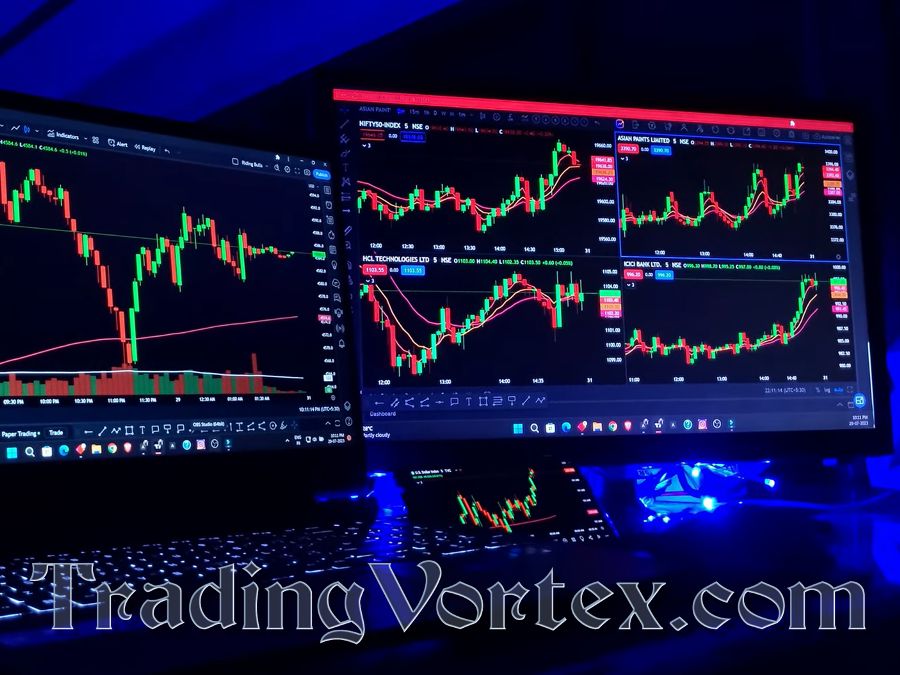Table Of Contents:
- Position Trading vs Swing Trading: A Comprehensive Comparison.
Advantages of Position Trading for Profitability:
Advantages of Swing Trading for Profitability:
Factors Impacting Profitability in Position and Swing Trading:
Managing Risks in Position and Swing Trading for Profit:
Choosing the Right Trading Strategy for You:
Conclusion: Profitability in Position Trading vs Swing Trading.
Position Trading vs Swing Trading: A Comprehensive Comparison.
Understanding Position Trading and Swing Trading:
Position Trading and Swing Trading are two distinct methodologies employed by traders and investors in the financial markets. To effectively compare their profitability, it is essential to grasp the fundamental differences and principles of each approach.
The Profitability Dilemma: Position Trading vs Swing Trading.
The ultimate question posed by this article is the age-old dilemma: which approach is more profitable, Position Trading or Swing Trading? To answer this, we will examine various factors that impact profitability in both strategies, as well as the unique advantages and drawbacks of each.
In the subsequent sections, we will delve deeper into the advantages and disadvantages of each trading style, examining how factors like market conditions, risk management, and psychological aspects can impact profitability in Position Trading and Swing Trading. By the end of this comprehensive comparison, you'll be better equipped to determine which trading approach aligns with your goals and risk tolerance.
Advantages of Position Trading for Profitability:
Position Trading is a trading strategy renowned for its potential to deliver substantial long-term profits. This section will explore the distinct advantages that make Position Trading an attractive choice for investors seeking extended profit potential.
Long-Term Profit Potential in Position Trading:
Position Trading thrives on the belief that long-term investments can yield substantial profits. Unlike shorter-term strategies, Position Trading allows traders to capitalize on the enduring price trends of financial instruments. By holding positions for months or even years, traders aim to accumulate significant returns over time.
The main advantage of this extended time horizon is the potential to capture the bulk of a major price trend. While shorter-term traders may enter and exit the market multiple times, Position Traders patiently wait for a trend to fully develop. This approach often leads to lower transaction costs and reduced exposure to short-term market fluctuations.
Position traders are particularly interested in assets with strong growth potential, such as stocks of companies with promising prospects, commodities with long-term supply-demand imbalances, or currencies with enduring macroeconomic drivers. By identifying and investing in these opportunities, Position Traders position themselves to benefit from the sustained appreciation of their chosen assets.
Capitalizing on Trends: Position Trading Strategies.
One of the cornerstones of Position Trading is the focus on trends. Traders who adopt this approach employ various technical and fundamental analysis tools to identify assets with clear and sustainable price trends. These trends may be driven by factors like economic indicators, corporate performance, or broader market dynamics.
Position Traders often implement trend-following strategies, using tools such as moving averages, trendlines, and momentum indicators to identify assets on the verge of a sustained uptrend. Once a trend is identified, traders establish long positions and hold them for the duration of the trend. This approach aligns with the "let your winners run" philosophy, where traders aim to maximize profits as a trend unfolds.
Effective Risk Management in Position Trading:
While Position Trading emphasizes long-term profit potential, it does not disregard the importance of risk management. Effective risk management is a key factor contributing to the profitability of this strategy. Position Traders often employ techniques such as stop-loss orders, portfolio diversification, and position sizing to mitigate potential losses.
By carefully managing risk, Position Traders can protect their capital and ensure they have the financial stability to withstand market volatility and unforeseen developments. This, in turn, contributes to the preservation of profitability over the long term.
Realizing Profit Potential: Position Trading Success Stories.
Position Trading has been instrumental in shaping the fortunes of numerous investors and fund managers who have successfully employed this strategy over the years. Here, we delve into some compelling real-world examples of Position Trading success stories, shedding light on how this approach can yield remarkable long-term profits.
Warren Buffett - The Oracle of Omaha:
Warren Buffett, often heralded as one of the most successful investors of all time, is a prominent advocate of Position Trading. His approach involves identifying undervalued companies with strong fundamentals and holding onto them for years, even decades. Berkshire Hathaway's substantial holdings in companies like Coca-Cola, Apple, and American Express exemplify this long-term investment philosophy. By sticking to his Position Trading principles, Buffett has accumulated immense wealth and remains a source of inspiration for investors worldwide.
George Soros - The Quantum Fund:
George Soros, through his Quantum Fund, executed a remarkable Position Trading strategy in 1992 when he "broke the Bank of England." He identified that the British pound was overvalued within the European Exchange Rate Mechanism (ERM) and took a massive short position against it. This trade resulted in a significant devaluation of the pound, earning Soros and his fund approximately $1 billion in profits in a single day. This demonstrates how a well-researched Position Trading strategy can capitalize on macroeconomic trends to achieve substantial returns.
Peter Lynch - The Magellan Fund:
Peter Lynch, renowned for his tenure as the manager of Fidelity's Magellan Fund, employed Position Trading to remarkable success. He held stocks for the long term, particularly in companies he thoroughly researched and believed in. Under his leadership, the Magellan Fund achieved an average annual return of approximately 29% over a 13-year period. Lynch's exceptional track record illustrates the potential for wealth accumulation through Position Trading when combined with rigorous fundamental analysis.
Buy-and-Hold Investors:
There are countless individual investors who have quietly realized substantial profits through Position Trading by adopting a buy-and-hold strategy. These investors typically choose assets like blue-chip stocks or index funds and retain them over extended periods. Over time, they benefit from capital appreciation, dividend income, and compounding returns. While they may not make headlines like the previously mentioned investors, their consistent, long-term profitability demonstrates the enduring effectiveness of Position Trading for those with patience and discipline.
These success stories highlight that Position Trading is not merely a theoretical concept but a proven strategy that has consistently delivered impressive profits to those who have diligently practiced it. The common thread among these stories is a commitment to holding quality assets for the long term, often in line with a well-defined investment philosophy. These investors have exemplified that Position Trading can be a pathway to substantial wealth accumulation when executed with expertise and perseverance.
Advantages of Swing Trading for Profitability:
Swing Trading is a dynamic trading strategy known for its agility and focus on capitalizing on short-term market fluctuations. In this section, we'll explore the distinct advantages that make Swing Trading an appealing choice for investors seeking quick gains and profit opportunities.
Navigating Short-Term Opportunities: Swing Trading.
Swing Trading is tailor-made for traders who wish to navigate the fast-paced world of short-term opportunities. Unlike Position Trading, which takes a patient approach, Swing Traders seek to identify and exploit price swings that can occur within days or weeks. By doing so, they can seize immediate profit potential in the market.
The primary advantage of Swing Trading lies in its responsiveness to market developments. Traders closely monitor technical indicators and news events to spot potential entry and exit points. They use technical analysis tools like candlestick patterns, moving averages, and relative strength indices to identify trends and reversals, allowing them to swiftly act on profitable opportunities.
Seizing Quick Gains: Swing Trading Strategies.
Swing Traders employ a diverse range of strategies to capitalize on short-term gains. These strategies often revolve around capturing price movements within a specific time frame, aligning with the belief that swift decisions can lead to substantial profits. Some of the most common Swing Trading strategies include:
- Momentum Trading: Swing Traders look for assets exhibiting strong momentum and buy or short-sell accordingly, aiming to profit from continued price movement.
- Breakout Trading: This strategy involves identifying key support or resistance levels and executing trades when prices break through these levels, potentially signaling a significant move.
- Reversal Trading: Swing Traders seek trend reversals by identifying overbought or oversold conditions, using tools like oscillators or divergences to find potential turning points.
These strategies allow Swing Traders to adapt to changing market conditions and swiftly capitalize on opportunities as they arise.
Mitigating Risks in Swing Trading:
While Swing Trading emphasizes short-term profit opportunities, it doesn't dismiss the importance of risk management. Effective risk mitigation strategies are critical to the profitability of this approach. Swing Traders often employ techniques such as stop-loss orders, position sizing, and portfolio diversification to protect their capital and limit potential losses.
By applying prudent risk management practices, Swing Traders ensure that they are financially equipped to weather market fluctuations and unexpected events. This, in turn, enhances their profitability by preserving capital and limiting downside risks.
Profiting from Swings: Notable Swing Trading Success Stories.
Swing Trading has created a platform for traders to capitalize on short-term market movements, offering the potential for substantial profits. Here, we explore a few remarkable success stories of individuals who have skillfully utilized Swing Trading to their advantage.
Jesse Livermore - The Legendary Stock Operator:
Jesse Livermore, often referred to as the "Boy Plunger" and "The Great Bear of Wall Street," was a legendary trader in the early 20th century. His name is synonymous with Swing Trading. Livermore's remarkable success lay in his ability to read market sentiment and identify significant price swings. His famous coup was short-selling stocks just before the 1929 stock market crash, earning him over $100 million, a colossal sum at that time.
Larry Williams - A Swing Trading Champion:
Larry Williams is renowned for winning the World Cup Championship of Futures Trading in 1987 by turning $10,000 into $1.1 million in a single year, primarily through Swing Trading. Williams is celebrated for his short-term trading strategies, which often involve identifying breakouts and capitalizing on market volatility. His success serves as a testament to the potential profitability of Swing Trading.
Mark Minervini - The Stock Market Wizard:
Mark Minervini, a stock trader and author, is a prime example of how Swing Trading can be employed to profit from stock market swings. Minervini is known for his meticulous research and systematic approach to Swing Trading. His noteworthy success includes winning the U.S. Investing Championship with an astounding 155% annual return. His journey showcases the rewards of disciplined trading and the ability to capture short-term opportunities.
Linda Raschke - A Pioneering Swing Trader:
Linda Raschke, one of the few prominent female traders, has left an indelible mark on the world of Swing Trading. With a career spanning over three decades, Raschke is known for her technical analysis skills and Swing Trading expertise. Her consistent profitability in the financial markets demonstrates the longevity and effectiveness of Swing Trading as a strategy.
These success stories highlight the diverse paths that traders can take within the realm of Swing Trading. From identifying market sentiment to harnessing technical analysis, these traders have effectively navigated the complexities of short-term market movements to achieve impressive profitability. Their accomplishments stand as a testament to the versatility and potential of Swing Trading as a strategy that empowers traders to profit from the dynamism of financial markets.
Factors Impacting Profitability in Position and Swing Trading:
Both Position Trading and Swing Trading are influenced by a multitude of factors that can impact their profitability. In this section, we explore the key factors that traders in these strategies must navigate to enhance their potential for success.
Market Conditions: Impact on Profitability.
- Trending Markets: Position Trading is often most profitable in strongly trending markets, as it allows traders to ride the trend and accumulate significant gains. In contrast, Swing Trading can adapt to various market conditions, including both trending and range-bound markets. Recognizing the prevailing market conditions is crucial for traders to align their strategies with the market environment.
- Volatility: Swing Trading can thrive in periods of market volatility, where price swings are more frequent and significant. On the other hand, Position Trading may experience challenges in highly volatile conditions, as it necessitates holding positions through turbulent price movements. Traders must adapt their strategies to the level of market volatility to maximize profitability.
The Psychological Aspect of Profitable Trading Strategies:
- Patience and Discipline: Position Trading often demands a great deal of patience and discipline. Traders must endure potential interim price fluctuations without panic or premature exits to realize long-term profitability. In contrast, Swing Traders must exercise discipline in executing timely entries and exits to capture short-term gains.
- Emotional Resilience: Emotional control is paramount for traders in both Position and Swing Trading. Overcoming fear, greed, and impulsive decisions is essential for maintaining profitability. Learning to manage emotions and stick to a predefined trading plan is crucial for long-term success.
Personal Suitability and Profitability in Trading:
- Risk Tolerance: Traders must evaluate their risk tolerance and align it with their chosen strategy. Position Traders may have a higher risk tolerance, given their willingness to withstand potential long-term market fluctuations. Swing Traders typically have a lower risk tolerance, as they expose themselves to shorter-term price movements. Assessing one's comfort with risk is vital in choosing the appropriate strategy for profitability.
- Time Commitment: Personal suitability also relates to the time commitment traders can allocate to their activities. Position Trading is less time-intensive as it involves infrequent trades and less market monitoring. Swing Trading requires more active involvement, with the need to analyze markets and execute trades more frequently. Evaluating the time one can devote to trading is crucial for selecting the strategy that best suits their lifestyle.
Adapting to Market Changes: Position vs. Swing Trading.
- Market Adaptability: Position Traders often face challenges when markets transition from trending to range-bound conditions. In contrast, Swing Traders can adapt to changing market conditions more swiftly. Traders must remain vigilant and adjust their strategies when the market dynamics shift to maximize profitability.
- Continuous Learning: The financial markets are dynamic and subject to constant change. Both Position and Swing Traders must invest in continuous learning and stay updated with the latest market trends and strategies. Adapting to new information and evolving market conditions is essential for sustained profitability.
Understanding these critical factors and their influence on profitability is essential for traders in both Position and Swing Trading. By comprehending the nuances of market conditions, the psychological aspects of trading, personal suitability, and the need for adaptability, traders can make informed decisions to enhance their profitability in these trading strategies.
Managing Risks in Position and Swing Trading for Profit:
Managing risks effectively is a fundamental aspect of both Position Trading and Swing Trading. In this section, we delve into the specific risk factors associated with each strategy and explore the strategies for mitigating those risks to maintain profitability.
Risk Factors in Position Trading: Mitigation Strategies.
- Market Risk: Position Traders are exposed to market risk over extended periods. To mitigate this risk, diversification plays a crucial role. By investing in a variety of assets, traders can spread their risk and reduce the impact of a single asset's poor performance on their overall portfolio.
- Fundamental Risk: Position Trading often relies heavily on fundamental analysis. To manage this risk, traders must conduct thorough research and analysis to select assets with strong fundamentals. Regularly monitoring and reassessing these fundamentals is essential to ensure they remain robust throughout the investment horizon.
- Interest Rate Risk: Position Traders in fixed income assets may be exposed to interest rate risk. To address this, traders can choose securities with maturities that align with their investment horizon. They can also employ techniques like laddering to spread out the risk over various maturity dates.
Risk Factors in Swing Trading: Effective Risk Management.
- Volatility Risk: Swing Traders are exposed to short-term price fluctuations, which can be influenced by market volatility. Effective risk management includes setting stop-loss orders to limit potential losses. Traders should also size their positions according to their risk tolerance.
- Overtrading Risk: The agility of Swing Trading can sometimes lead to overtrading, which can result in higher transaction costs and losses. To mitigate this risk, traders must adhere to a predefined trading plan, only entering positions when their criteria are met, and avoiding impulsive trades.
- Gap Risk: Gaps in prices can occur overnight or during market opens, leading to potential gaps in traders' portfolios. To manage this risk, Swing Traders can employ risk-reducing strategies, such as using limit orders to close positions and avoid unexpected price gaps.
Common Pitfalls and Their Impact on Profitability:
- Lack of Discipline: Both Position and Swing Traders can suffer from a lack of discipline, which can result in impulsive trading decisions. This can erode profitability by leading to premature exits, overtrading, or ignoring risk management strategies. To avoid this pitfall, traders must adhere to their predetermined trading plans and exercise emotional control.
- Failure to Adapt: Market conditions are dynamic, and traders who fail to adapt their strategies may face diminished profitability. Position Traders need to recognize when to adjust their long-term positions, while Swing Traders must be agile in modifying their strategies in response to changing market conditions.
- Overleveraging: Excessive leverage can amplify both gains and losses. Position Traders may use leverage sparingly, and Swing Traders must exercise caution when using margin accounts. Overleveraging can lead to catastrophic losses and hinder overall profitability.
By understanding the specific risks associated with Position and Swing Trading and implementing effective risk management strategies, traders can enhance their potential for profit while protecting their capital. Avoiding common pitfalls and continuously refining their trading practices is integral to maintaining profitability in these dynamic trading strategies.
Choosing the Right Trading Strategy for You:
Selecting the optimal trading strategy is a pivotal decision that aligns with your individual goals and risk tolerance. In this section, we explore the critical factors that will aid you in choosing the trading strategy that suits your unique needs and aspirations.
Assessing Your Trading Goals and Risk Tolerance:
- Define Your Goals: The first step in choosing the right trading strategy is to clearly define your trading goals. Are you seeking consistent, long-term growth (Position Trading) or are you inclined towards quick, short-term gains (Swing Trading)? Establishing your objectives is crucial in determining the appropriate strategy.
- Evaluate Your Risk Tolerance: Assess your risk tolerance accurately. Position Trading generally demands a higher risk tolerance due to its extended investment horizon and exposure to market fluctuations. On the other hand, Swing Trading tends to suit those with a lower risk tolerance, as it involves shorter timeframes and the potential for quicker losses.
Customizing Your Approach for Profitability:
- Adapt to Your Lifestyle: Your daily schedule and availability to monitor markets play a pivotal role. Position Trading is less time-intensive and suits individuals with busier schedules, as it involves infrequent decision-making. Swing Trading requires more active involvement, making it more compatible with those who can dedicate more time to their trading activities.
- Develop a Trading Plan: Irrespective of your chosen strategy, a well-structured trading plan is vital. This plan should encompass entry and exit rules, risk management strategies, and criteria for asset selection. Having a trading plan in place will help you stay disciplined and reduce emotional decision-making.
- Practice with a Demo Account: If you are new to trading or considering a switch in strategy, practice with a demo account. This allows you to gain experience and test your strategy without risking real capital. It's a valuable step in refining your approach and improving profitability.
Achieving Balance: Combining Position and Swing Trading Strategies.
- Diversify Your Portfolio: Some traders find success in combining Position and Swing Trading strategies. By doing so, they can diversify their portfolio and leverage the benefits of both long-term and short-term positions. Diversification can help spread risk and optimize profitability.
- Be Adaptable: As your financial situation and market conditions evolve, be ready to adapt your trading strategy. What suits you today might not be the best choice tomorrow. Continuously evaluate your strategy and make adjustments as needed.
In the end, choosing the right trading strategy is a highly personal decision. It hinges on your financial goals, risk tolerance, available time, and your ability to stay disciplined. The key to profitability lies in aligning your chosen strategy with your individual circumstances and aspirations. By assessing these factors and customizing your approach, you can increase your chances of success in the dynamic world of trading.
Conclusion: Profitability in Position Trading vs Swing Trading.
As we conclude our exploration of Position Trading vs Swing Trading, it becomes evident that there is no one-size-fits-all answer to the question of which strategy is more profitable. Instead, the choice between these two approaches hinges on your individual circumstances, goals, and trading style. Here are some key takeaways from our analysis:
The Lack of a One-Size-Fits-All Answer:
The financial markets are dynamic and diverse, offering an array of opportunities for traders and investors. Position Trading and Swing Trading represent two distinct paths, each with its unique advantages and challenges. Position Trading caters to those with long-term vision and the patience to weather market fluctuations, while Swing Trading suits individuals seeking quick gains and the ability to adapt to rapidly changing market conditions.
The profitability of each strategy depends on various factors, including your risk tolerance, time commitment, and the market environment. What works for one trader may not necessarily work for another. The absence of a one-size-fits-all answer underscores the importance of aligning your trading approach with your specific goals and circumstances.
The Ongoing Debate: Position Trading vs Swing Trading.
The debate between Position Trading and Swing Trading remains ongoing in the trading community. Both strategies have their proponents and success stories. Position Traders argue that the potential for substantial long-term gains justifies the patience and discipline required. In contrast, Swing Traders advocate for the nimbleness and ability to capture short-term opportunities that Swing Trading offers.
Rather than seeking a definitive answer, traders should approach this debate as an opportunity to learn from the experiences and insights of practitioners in both camps. This ongoing discourse enriches the trading landscape and encourages individuals to explore and refine their trading strategies continually.
Final Thoughts on Maximizing Profitability:
In our final thoughts, it's important to highlight that both Position Trading and Swing Trading can be profitable when executed with precision, discipline, and effective risk management. Whichever strategy you choose, remember that profitability in trading is not solely determined by the strategy itself but by your ability to apply it effectively.
To maximize profitability, consider the following:
- Align your chosen strategy with your trading goals and risk tolerance.
- Develop a robust trading plan that includes entry and exit criteria, risk management, and asset selection criteria.
- Stay disciplined and emotionally resilient, as emotions can erode profitability.
- Continuously adapt to changing market conditions and stay informed about evolving strategies and techniques.
Ultimately, the decision between Position Trading and Swing Trading is a highly individual one. Profitability hinges not only on the strategy you select but on your commitment, knowledge, and adaptability as a trader. By combining the right strategy with the right mindset, you can enhance your potential for success in the world of trading.








































